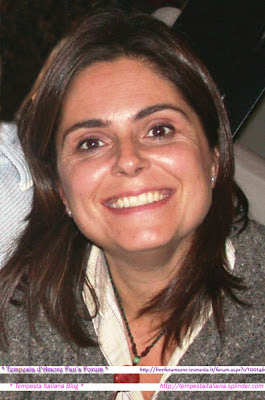Tempesta Italiana intervista Luisa Ziliotto, doppiatrice di Marlene Schweitzer
Dopo qualche tempo tornano le grandi interviste di Tempesta Italiana con un personaggio molto amato dai fans di Tempesta D'Amore con cui abbiamo avuto modo di parlare anni fa. Stiamo parlando di Luisa Ziliotto, strepitosa doppiatrice di Miriam Saalfeld (Inez Bjorg David) e attualmente voce di Marlene Schweitzer, protagonista dell'ottava stagione.
La brava doppiatrice ha gentilmente risposto alle mie domande riguardo la sua esperienza passata e presente a Tempesta D'Amore nel corso di un'intervista, assolutamente da non perdere che pone l'accento su una questione che da sempre incuriosisce i telespettatori, il doppiaggio.
Qui di seguito potrete leggerla, conoscendo meglio Luisa Ziliotto che ancora per diversi mesi ci accompagnerà nei panni della protagonista.
1. Eccoci di nuovo qui, a cinque anni dalla nostra intervista per parlare ancora con te di Tempesta D'Amore, questa volta non più di Miriam Saalfeld (Inez Bjorg David) bensì di Marlene Schweitzer (Lucy Scherer). La prima domanda d'obbligo però è, avendo doppiato la Von Heidenberg, cosa ne pensi della decisione degli autori di eliminare il personaggio?
Come avrete notato quasi tutti i protagonisti giovani durano un certo numero di puntate (circa 200) e poi vengono sostituiti, purtroppo per noi doppiatori ma per fortuna per il pubblico che vede facce nuove! Miriam era stata allontanata per un po' credo perché aveva altri ingaggi e poi non è più tornata...forse l'attrice non era simpaticissima alla produzione o forse aveva altro da fare (so che ha avuto un figlio...)
2. Parlando di questioni più piacevoli: che cosa hai pensato quando ti è stata affidata la voce di Marlene? Sei la prima doppiatrice a prestare la voce a due diverse protagoniste, un bel record!
Ovviamente ne sono stata molto contenta! Erano circa 5 anni che non lavoravo più nella produzione e la Dea Bendata mi ha assistito! Per quanto riguarda il "riciclaggio voci", non saprei...i casting sono anonimi, se mi hanno scelta è perché mi hanno considerata idonea a doppiare anche Marlene o perché non mi hanno riconosciuta!!!
3. Quando hai accettato di doppiare Marlene ti sei anche chiesta come avrebbe reagito il pubblico di Tempesta, ascoltando la 'voce di Miriam' su un'altra attrice?
Ho pensato che qualcuno avrebbe criticato questa scelta ma...le facce cambiano-le voci cambiano (nel senso che se gli attori sono diversi dobbiamo adeguarci ai nuovi ruoli modificando il timbro di voce, le intonazioni, le diverse intenzioni), chissà quanti mi avrebbero riconosciuta se non avessero letto il mio nome tra i doppiatori!
4. Rivolgendoti allo stesso pubblico che ha amato Miriam, come hai lavorato sul personaggio di Marlene per diversificarlo?
I caratteri di Miriam e Marlene sono abbastanza simili e per certi versi anche le loro storie...per riuscire a diversificare i due personaggi ci si deve fidare dei direttori di doppiaggio e del proprio istinto!
5. Cosa ne pensi del personaggio di Marlene?
Ammetto che all'inizio non mi era così simpatica...troppo succube di sua madre e poco autonoma nelle scelte...ma adesso mi ci sto affezionando e confido in una svolta nella sua vita (l'amore per Konstantin?) che la renderà più matura e indipendente.
6. Se fossi in lei sceglieresti Michael o Konstantin?
Per adesso sta con Michael ed è innamorata di lui, anche se sono molto diversi...ma presto si renderà conto che il vero amore è un altro e che ha molti più punti in comune con Konstantin che con Michael; personalmente, dovessi scegliere? Sono sposata e non guardo gli altri uomini!!!
7. Come forse saprai Lucy Scherer è anche una cantante e presto in Germania andrà in onda un momento clou nel corso del quale interpreterà la canzone simbolo del suo amore per Konstantin proprio insieme a lui. Anche tu ti diverti a cantare?
Sì, mi piace cantare...ogni tanto faccio la corista nel gruppo di mio marito ma le cantanti brave sono altre :-)
8. Hai avuto modo di conoscere Lucy Scherer? E se non è così che le diresti se la dovessi incontrare?
Non conosco personalmente l'attrice ma la trovo molto carina e spiritosa.
9. Ci puoi raccontare qualche retroscena divertente riguardo al doppiaggio? Ad esempio con Luigi Rosa (voce di Konstantin), Andrea Zalone (voce di Michael) o con Cristina Giolitti (voce di Natascha)?
Per questioni economiche e di tempo ognuno di noi doppia quasi sempre da solo in studio, quindi non ho grandi aneddoti (bei tempi quelli di Miriam e Robert in cui si doppiava sempre insieme e ci si divertiva un mondo...ma la crisi si sente eccome!!!)...ogni tanto la mamma (Cristina Giolitti e io, siamo molto amiche) mi lascia qualche simpatico messaggino sul copione...e io le rispondo a tono!
10. A breve Lucy Scherer lascerà il cast di Tempesta D'Amore. Sei dispiaciuta di dover nuovamente abbandonare il doppiaggio della soap?
Sono molto dispiaciuta ma mi ritengo fortunata...se avessero scelto un'altra doppiatrice non sarei qui a rispondere alle vostre domande...
11. Presti anche la voce ad un altro personaggio di una soap tedesca, Isabelle Lisson (Cecilie Bagieu) di Lena - Amore della mia vita. Come è stato calarsi in un personaggio un po' sopra le righe come il suo?
Doppiare Lena mi ha divertito molto, direi che è un personaggio davvero "nelle mie corde"! Buffa, spiritosa ed espressiva, Cecilie Bagieu è un'attrice che spero di rincontrare nel mio cammino
12. Se hai voglia e se puoi, anticipaci dove ti potremo ascoltare, quando Marlene non sarà più in scena.
Non sto lavorando molto, a parte Tempesta sono su qualche documentario ma nessun personaggio così interessante...incrociate le dita per me!!!
Ti ringraziamo ancora tanto per la tua disponibilità. Un abbraccio da parte di tutti i fans.









